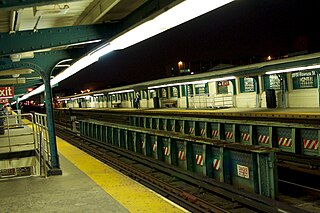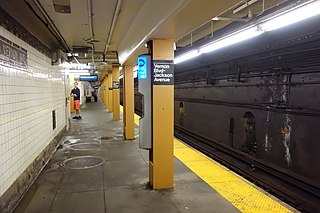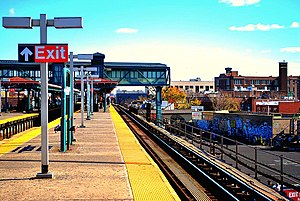
The 7 Flushing Local and <7> Flushing Express are two rapid transit services in the A Division of the New York City Subway, providing local and express services along the full length of the IRT Flushing Line. Their route emblems, or "bullets", are colored purple, since they serve the Flushing Line.

The Flushing–Main Street station is the eastern terminal on the IRT Flushing Line of the New York City Subway, located at Main Street and Roosevelt Avenue in Downtown Flushing, Queens. It is served by the 7 local train at all times and the <7> express train during rush hours in the peak direction.

The Mets–Willets Point station is a rapid transit station on the IRT Flushing Line of the New York City Subway. Located near the Citi Field baseball stadium, it is served by the 7 train at all times and by the express <7> train rush hours in the peak direction or after sporting events. This station is located near Flushing Meadows–Corona Park in Willets Point, Queens, on Roosevelt Avenue between 114th and 126th Streets.

The 111th Street station is a local station on the IRT Flushing Line of the New York City Subway, located at the intersection of 111th Street and Roosevelt Avenue. It is served by the 7 train at all times.

The 103rd Street–Corona Plaza station is a local station on the IRT Flushing Line of the New York City Subway, located at the intersection of 103rd Street and Roosevelt Avenue. It is served by the 7 train at all times.

The 61st Street–Woodside station is an express station on the IRT Flushing Line of the New York City Subway located at 61st Street and Roosevelt Avenue in Woodside, Queens. It is served by the 7 train, with additional peak-direction <7> service during rush hours.

The Queensboro Plaza station is an elevated New York City Subway station at Queens Plaza in the Long Island City neighborhood of Queens. It is near the east end of the Queensboro Bridge, with Queens Boulevard running east from the plaza. The station is served by the 7 and N trains at all times, the W train on weekdays, and the <7> train rush hours in the peak direction.

The 90th Street–Elmhurst Avenue station is a local station on the IRT Flushing Line of the New York City Subway, located at 90th Street and Elmhurst Avenue in Elmhurst, Queens. It is served by the 7 train at all times.

The 82nd Street–Jackson Heights station is a local station on the IRT Flushing Line of the New York City Subway, located at the intersection of 82nd Street and Roosevelt Avenue in Jackson Heights, Queens. It is served by the 7 train at all times. The Manhattan-bound track is being upgraded and is not in service.

The 69th Street station is a local station on the IRT Flushing Line of the New York City Subway. Located at 69th Street and Roosevelt Avenue in the Woodside, Queens, it is served by the 7 train at all times.

The 52nd Street station is a local station on the IRT Flushing Line of the New York City Subway. Located at the intersection of 52nd Street and Roosevelt Avenue in Woodside, Queens, it is served by the 7 train at all times.

The 46th Street–Bliss Street station is a local station on the IRT Flushing Line of the New York City Subway. Located at the intersection of 46th Street and Queens Boulevard in Sunnyside, Queens, it is served by the 7 train at all times.

The 40th Street–Lowery Street station is a local station on the IRT Flushing Line of the New York City Subway. It is served by the 7 local train at all times.

The 33rd Street–Rawson Street station is a local station on the IRT Flushing Line of the New York City Subway. It is located over Queens Boulevard on a concrete viaduct. It is served by the 7 train at all times.

The Vernon Boulevard–Jackson Avenue station is a station on the IRT Flushing Line of the New York City Subway, and the westernmost station on the Flushing Line in Queens. It is served by the 7 train at all times and the <7> train rush hours in the peak direction. Although there is a nearby intersection of Vernon Boulevard and Jackson Avenue, the station is located one block north of that intersection, on 50th Avenue, between Vernon Boulevard and Jackson Avenue, both of which have entrances to the station.
The IRT Flushing Line is a rapid transit route of the New York City Subway system, named for its eastern terminal in Flushing, Queens. It is operated as part of the A Division. The Interborough Rapid Transit Company (IRT), a private operator, had constructed the section of the line from Flushing, Queens, to Times Square, Manhattan between 1915 and 1928. A western extension was opened to Hudson Yards in western Manhattan in 2015, and the line now stretches from Flushing to Chelsea, Manhattan. It carries trains of the 7 local service, as well as the express <7> during rush hours in the peak direction. It is the only currently operational IRT line to serve Queens.
The BMT Astoria Line is a rapid transit line of the B Division of the New York City Subway, serving the Queens neighborhood of Astoria. It runs south from Ditmars Boulevard in Astoria to 39th Avenue in Long Island City above 31st Street. It then turns west and serves Queensboro Plaza over Queens Plaza.

The Astoria–Ditmars Boulevard station, is the northern terminal station on the BMT Astoria Line of the New York City Subway. Located above 31st Street between 23rd Avenue and Ditmars Boulevard in Astoria and Ditmars, Queens, it is served by the N train at all times and the W train on weekdays.

The Astoria Boulevard station is an express station on the BMT Astoria Line of the New York City Subway. Located on 31st Street between Astoria Boulevard and the Grand Central Parkway in Astoria, Queens, the station is served by the N train at all times, as well as by the W train on weekdays.

The Jackson Heights–Roosevelt Avenue/74th Street station is a New York City Subway station complex served by the IRT Flushing Line and the IND Queens Boulevard Line. Located at the triangle of 74th Street, Broadway, and Roosevelt Avenue in Jackson Heights, Queens, it is served by the 7, E, and F trains at all times; the R train at all times except late nights; and the <F> train during rush hours in the reverse peak direction.























